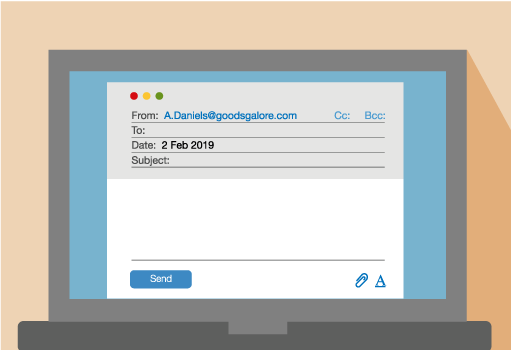5.1 Writing emails
Emails are used for both formal and informal communication. In the workplace, they are used internally (within an organisation) and externally (from one organisation to another). At home, they are used for social and business purposes, from arranging to meet friends to contacting a solicitor. They can be as formal as a business letter or as informal as a scribbled note to a friend; it all depends on the context.
When you write an email, there are usually From, To, cc and Subject (or Re) sections above the message section.
Your own email address is automatically shown in the From box.
Email is quick and easy to use. Messages reach the person they are addressed to almost instantly. Because email is so quick and easy, there are some special points to bear in mind when planning an email message:
- Give your message a clear, informative title as many people receive dozens of emails each day.
- Keep your message short and to the point.
- At work, use a polite, formal style (chatty shorthand isn’t acceptable).
- Be careful what you say; never assume an email is confidential.
This is the usual structure of an email, although not all will be exactly the same:
- the recipient’s address
- the subject of the email
- the greeting
- the body of the email
- the closing/sign-off.
Greetings and closings
Greetings and closings in an email are more flexible than in a letter.
If you are writing a formal email (for a job application, for example), you can still use the formal ‘Dear Sir/Madam’ used in a letter. However, you are more likely to know the name of the person you are writing to, so to set a friendly tone you can address the person by name.
If the email is formal and you don’t know the person you are emailing well, use ‘Dear’. If you know the person, ‘Hi’ is often fine.
You can use ‘Yours faithfully’ to close an email, but ‘Kind regards’ or ‘Best regards’ are more common.
Activity 29 Planning an email
Imagine your manager, Winston Davis, has asked you to book a room at a local hotel for a meeting on 6 January. Winston is expecting ten people to attend including someone in a wheelchair who will be giving a PowerPoint presentation. Winston said the meeting will last all day so you need to organise lunch and refreshments. He also mentioned that the last time the company used the hotel there was a very noisy private party going on that interfered with the meeting.
When you contact the hotel’s conference manager, Ms Dhami, she asks you to confirm your requirements by email.
Try planning an email to Ms Dhami. Make a list of the essential information that you must include and optional information that you might include.
Discussion
See how your points compare with the following:
Must include:
- To: Ms Dhami’s email address.
- Subject: Meeting.
- Cc: Winston Davis’ email address.
- Purpose of email.
- Date and time of meeting.
- Number of people attending.
- Requirements of food and refreshments.
- Wheelchair access.
- Powerpoint presentation facilities.
Might include:
- Problem with noise at the last meeting.
The information in the first list is all essential. The only point that is not essential, as shown in the second list, is the fact that last time there was too much noise nearby.


